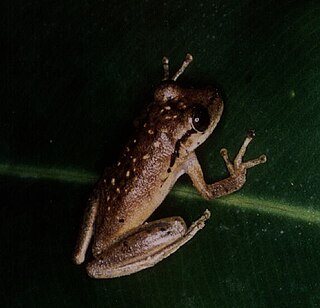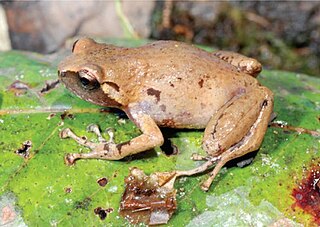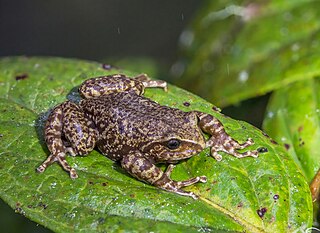
Amphibians are ectothermic, anamniotic, four-limbed vertebrate animals that constitute the class Amphibia. In its broad sense, it is paraphyletic group encompassing all tetrapods excluding the amniotes. All extant (living) amphibians belong to the monophyletic subclass Lissamphibia, with three living orders: Anura (frogs), Urodela (salamanders), and Gymnophiona (caecilians). Evolved to be mostly semiaquatic, amphibians have adapted to inhabit a wide variety of habitats, with most species living in freshwater, wetland or terrestrial ecosystems. Their life cycle typically starts out as aquatic larvae with gills known as tadpoles, but some species have developed behavioural adaptations to bypass this.

A frog is any member of a diverse and largely carnivorous group of short-bodied, tailless amphibians composing the order Anura. The oldest fossil "proto-frog" Triadobatrachus is known from the Early Triassic of Madagascar, but molecular clock dating suggests their split from other amphibians may extend further back to the Permian, 265 million years ago. Frogs are widely distributed, ranging from the tropics to subarctic regions, but the greatest concentration of species diversity is in tropical rainforest. Frogs account for around 88% of extant amphibian species. They are also one of the five most diverse vertebrate orders. Warty frog species tend to be called toads, but the distinction between frogs and toads is informal, not from taxonomy or evolutionary history.

Toad is a common name for certain frogs, especially of the family Bufonidae, that are characterized by dry, leathery skin, short legs, and large bumps covering the parotoid glands.

The glass frogs belong to the amphibian family Centrolenidae. While the general background coloration of most glass frogs is primarily lime green, the abdominal skin of some members of this family is transparent and translucent, giving the glass frog its common name. The internal viscera, including the heart, liver, and gastrointestinal tract, are visible through the skin. When active their blood makes them visible; when sleeping most of the blood is concealed in the liver, hiding them. Glass frogs are arboreal, living mainly in trees, and only come out for mating season. Their transparency conceals them very effectively when sleeping on a green leaf, as they habitually do.

Scinax is a genus of frogs in the family Hylidae found in eastern and southern Mexico to Argentina and Uruguay, Trinidad and Tobago, and Saint Lucia. These are small to moderate-sized tree frogs, drably colored. Duellman and Wiens resurrected this genus in 1992. The name originates from the Greek word skinos, meaning quick or nimble.

Pseudacris is a genus of frogs in the family Hylidae found in North America ranging from the Pacific coastline to the Atlantic.

Phyllodytes is a genus of frogs in the family Hylidae. It is endemic to eastern Brazil.

Osteocephalus is a genus of frogs, the slender-legged tree frogs, in the family Hylidae found in the Guianas, the Amazon Basin, Venezuela, Colombia, southeastern Brazil, and north-eastern Argentina. Males are warty, while females are smooth.

Oreophryne, the cross frogs, is a genus of microhylid frogs endemic to Southern Philippine, Celebes and the Lesser Sunda Islands, and New Guinea.

The yellow-striped pygmy eleuth, also known as the yellow-striped dwarf frog, is a species of frog in the family Eleutherodactylidae from closed mesic and xeric forests in Cuba.

Crossodactylus is a genus of frogs in the family Hylodidae. The genus occurs in Brazil, southern Paraguay, and northern Argentina. These frogs are sometimes known as Limnocharis, Tarsopterus, Calamobates, and by the common name spinythumb frogs. They typically inhabit streams in mountainous areas in the Atlantic Forest or in montane savanna.

Pristimantis acuminatus is a species of frog in the family Strabomantidae. It is found in the Amazon rainforest of Ecuador, northern Peru, and adjacent Colombia and Brazil. It is a lowland Amazonian rainforest species that also occurs on the lower reaches of the Andes. At night these frogs can be found perched on leaves some 10–15 m (33–49 ft) above the ground; during the daytime they may be found in bromeliads or sleeping on the undersides of leaves. It may also occur in cultivated areas. This widespread species is not considered threatened.

The black-crowned antpitta is a species of bird in the gnateater family, Conopophagidae. It is found in Colombia, Costa Rica, and Panama. Its natural habitat is subtropical or tropical moist foothill forests.

The Congo clawless otter, also known as the Cameroon clawless otter, is a species in the family Mustelidae. It was formerly recognised as a subspecies of the African clawless otter.

Hyloidea is a superfamily of frogs. Hyloidea accounts for 54% of all living anuran species. The superfamily Hyloidea branched off from its closest relative, the Australobatrachia, during the mid-Cretaceous. The fossil evidence found during the Cretaceous-Paleogene extinction event could not determine the effects upon the frogs, due to the lack of fossils. Increased forestation erupted after this extinction, possibly leading to more arboreal adaptations of these anurans to be best suited for this habitat.

Pristimantis is a very large genus of frogs distributed in the southern Caribbean islands and in Central and South America from Honduras to northern Argentina and southern Brazil. With 596 described species, the genus had more species than any other genus of vertebrate animals. Many of these species genus are endemic to the Northwestern Andean montane forests ecoregion in north-western South America.

The Hemiphractidae are a family of frogs from South and Central America. Previously, this group had been classified as a subfamily (Hemiphractinae) under family Hylidae. More recent research classifies these genera into their own family, or sometimes into three separate families: Amphignathodontidae, Cryptobatrachidae, and Hemiphractidae. An active question still exists as to which of these groupings is more accurate.

Paedophryne amauensis is a species of microhylid frog endemic to eastern Papua New Guinea. At 7.7 mm (0.30 in) in snout-to-vent length, it is considered the world's smallest known vertebrate.
Hyloxalus leucophaeus is a species of frog in the family Dendrobatidae. It is endemic to a very limited range in Peru.

Leucostethus is a genus of frogs in the family Dendrobatidae, in the subfamily Colostethinae. The frogs are found in the western Amazon rainforest.


















